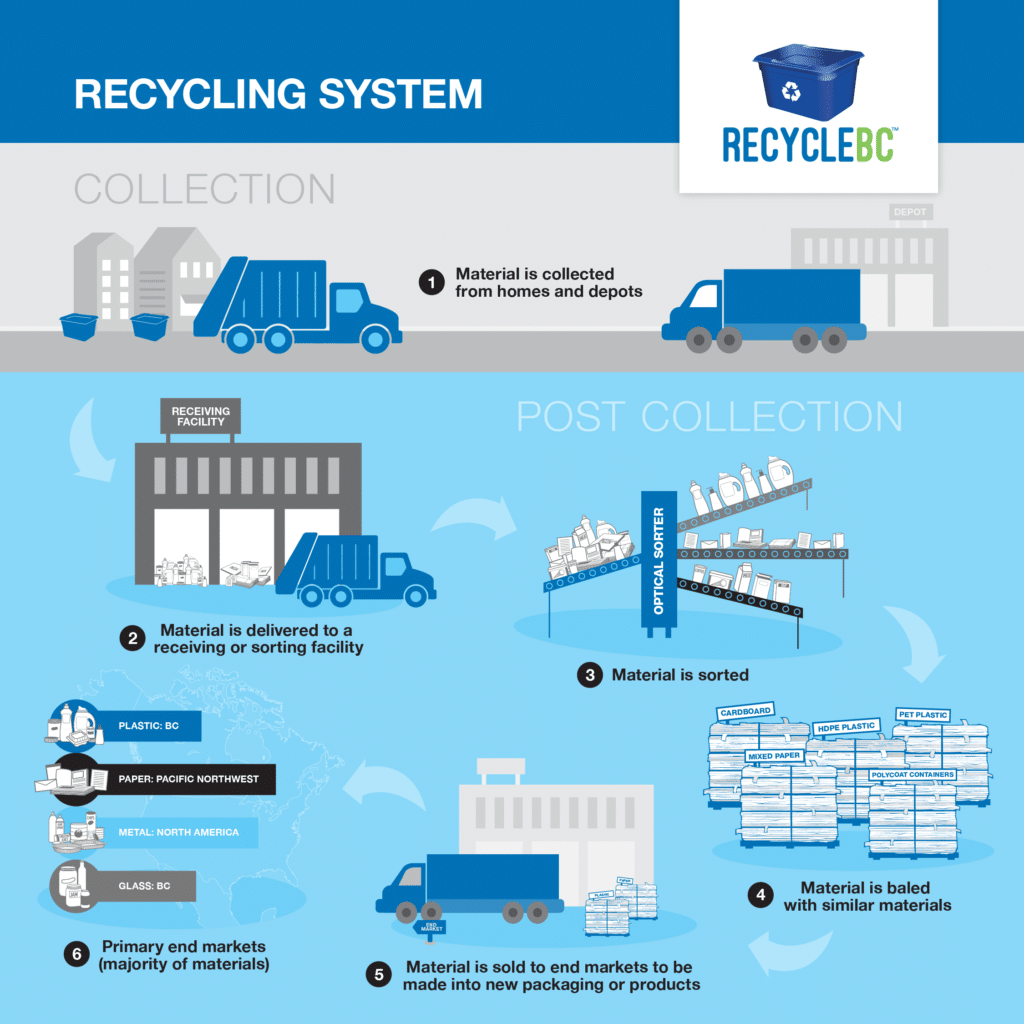The Crux of Recycling:
Competency & Contamination
Hello, we are Courtney Baker and Kieran Giles and this blog is the culmination of the work done by our group, ‘I Have a tRash‘, on the recycling habits at the University of Victoria. We gathered, analyzed and interpreted data from material waste found in the Visual Arts Building, as well as collected survey data to gauge the opinions of those whom the trash may have represented. The map below shows the classes combined area of data collection, with our area of study marked by the yellow star, on far left of the image.

Map of the University of Victoria’s main campus, showing the generalized locations where trash was collected from & interviews taken at. Original image retrieved from UVic’s ‘Maps & Buildings’ Page, edited by Courtney Baker.
We specifically chose the Visual Arts Building for the perceived availability of unique, art-derived trash that would differ from typically disposed of items, including plastics, food & beverages containers. We expected to find textiles, pens, paints or even discarded artwork, hoping to better understand people’s thought processes when deciding to/not to recycle, and what defines the value of an item when it’s being disposed of? Unfortunately, we found only 3 unique, art-related items, making these questions hard to answer. However, we have three theories as to why there was such a lack of art-related waste:
ONE: The recycled materials we recovered could have been collected too early in the semester. Meaning, major art projects or end-of term exhibitions were not yet underway, as of yet leaving no unique waste.
TWO: Our collection sites were solely in public areas: we did not collect from the many classroom’s receptacles. Thus, individuals may have instead disposed of their waste in these studio bins.
THREE: Survey and material data suggest that the Visual Arts Building is largely waste-conscious. Thus, “scrap” material can be repurposed for use in future projects and not representative in our findings.

One of three Sort-It-Out station from the Visual Arts Building. Photo credit: Courtney Baker
A notable issue with UVIC’s recycling habits, lies within the sorting competency of its populace. Both BC Recycle (as of April 2019) and our own surveys (collected October 15-17, 2021) indicate a 94% and 84% rate of sorting competency, respectively. However, these commendable scores are contested by the material data which, in our case, was only 65% sorted correctly. This is nearly a 20% difference in confidence scores that represents an considerable overconfidence of the UVIC population in how well they claim to recycle compared to how well they actually recycle.
A second notable issue in UVIC’s recycling habits is contamination. This topic is discussed more thoroughly in this 15:25 video from CBC. We suspect that the underlying myth—“there’s no point in recycling, because it all ends up in the landfill anyways”— leads to further levels of contamination.
THIS IS SIMPLY NOT TRUE!
This local, Vancouver news station debunks this myth well in their 2:20 video. Basically, every time ONE item is sorted incorrectly, there is the potential that is can and will contaminate the entire bin of properly sorted items it is in. This is problematic, as many of these contaminated items can no longer be recycled. It was not only our group who experienced such a reality, in fact most groups, including ‘Old Hat‘ and the ‘Trash Talkers‘ also reported high rates of improperly sorted items due to contamination.
In our previous paper, we suggested remedies for competency and contamination, primarily through the increase of visual aids and better engagement between institutions and individuals. Our surveys results indicate a general desire for increased visual aids on Sort-It-Out stations. While visual aids already exist for accepted items, there is only fine-print text explaining what items are not accepted.
While we recognize that institutional changes might be tricky to navigate, individuals themselves must be incentivized to acquaint themselves with evolving recycling guidelines. When institutional guidelines are not suitable, we suggest a grassroots approach to spur the necessary recycling education.
Improved rates of recycling need not change as much as one might think! There are already many large recycling companies doing it beautifully. Efforts by Recycle BC provide accessible media engagement through visual aids. Videos, like those linked here, as well as browser games to test your recycling knowledge, exemplify these efforts, and just how well recycling systems already work! However, cities, province’s and countries seem to be in competition of each other, despite relatively similar structures. Our final suggestion is that we standardize recycling practice throughout the country, if not globally, with uniform visuals and aids to reduce potential confusion when sorting recyclable items. Doing so would mitigate many of the issues presently affecting recycling habits and hopefully help amend overconfident habits and inconsistent instructions.

Interested to know more about where your recyclables go once they’ve been collected from your bins? Many categories including hard plastics, metal containers, paper and glass all either have markets or are processed here in BC, but are also accepted by other markets either overseas or in the United States. Recycle BC has an interesting, 3:15 video that tells you all about this!

This visual aid highlights how Recycle BC’s system processes new, raw materials from recycled goods. This information is also accessible in this 3:39 video from Recycle BC.
749 words


0 Comments